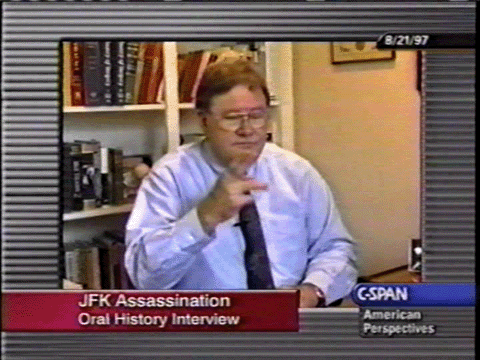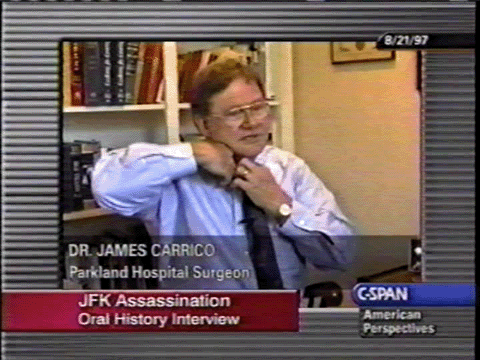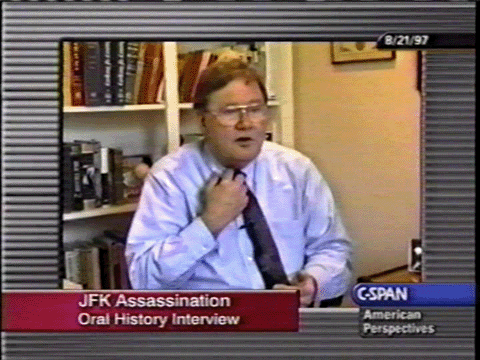by TODD W. VAUGHAN
Over the last few weeks, I've shown that Gerald McKnight's claim that the tears in the President's shirt had nothing to do with the bullet wound in his throat and were somehow caused by a nurse's scalpel was a rather ironic distortion of the historic record considering this all began with McKnight's claim that Vincent Bugliosi misrepresented the truth on this very issue in his recent book "Reclaiming History: The Assassination of President John F. Kennedy."
Last week while reviewing hundreds of assassination related video tapes I had collected over the last thiry years, I came across one containing a series of oral histories that had been gathered by The Sixth Floor Museum at Dealey Plaza in Dallas, Texas, and which had subsequently been broadcast on CSPAN.
One of those interviews, conducted on August 2, 1977 [CSPAN incorrectly lists the date as August 21, 1997] by Bob Porter, long-time Public Relations Director of The Sixth Floor Museum, was with Dr. James Carrico, the Parkland Hospital doctor who first saw President Kennedy in the emergency room. Dr. Carrico is the doctor whom, according to conspiracy author Harold Weisberg, stated that the wound in the President’s throat was above the collar line and that the tears in the collar had been made by a nurse using a scalpel to cut off the President’s clothing. Gerald McKnight had recently resurrected Weisberg’s claims in his article, “Bugliosi Fails to Resuscitate the Single-Bullet Theory”.
During the interview, Porter, who was apparently aware of the controversy surrounding the question of whether or not the throat wound was above or below the collar, asked Dr. Carrico about it.
Here is an excerpt from the relevant portion of that oral history:
DR. CARRICO: “...We saw, uh, he had a little hole right...”
MR. PORTER: (interrupting) “Was that abo-an-another sort of controversial thing is - what - was it, above his, his collar line, or slightly below it?”
DR. CARRICO: “By, by the time I looked, Diane, the nurse had - had started taking his clothes off. Which - which was her job so I really didn’t - don’t know...”
MR. PORTER: (talking over) “You don’t know exactly where it was or not?”
DR. CARRICO: (continuing) "...whether it was through the collar or not but it was certainly at the collar line. It was just about right there, just to the right of the trachea and just a, certainly where his collar should have been.”
MR. PORTER: “She was the one that removed the tie?”
DR. CARRICO: “Uh, yeah, she..."
At this point Dr. Carrico used the fingers on his right hand to form an imaginary pair of scissors and made a clipping action with them.
Over the last few weeks, I've shown that Gerald McKnight's claim that the tears in the President's shirt had nothing to do with the bullet wound in his throat and were somehow caused by a nurse's scalpel was a rather ironic distortion of the historic record considering this all began with McKnight's claim that Vincent Bugliosi misrepresented the truth on this very issue in his recent book "Reclaiming History: The Assassination of President John F. Kennedy."
Last week while reviewing hundreds of assassination related video tapes I had collected over the last thiry years, I came across one containing a series of oral histories that had been gathered by The Sixth Floor Museum at Dealey Plaza in Dallas, Texas, and which had subsequently been broadcast on CSPAN.
One of those interviews, conducted on August 2, 1977 [CSPAN incorrectly lists the date as August 21, 1997] by Bob Porter, long-time Public Relations Director of The Sixth Floor Museum, was with Dr. James Carrico, the Parkland Hospital doctor who first saw President Kennedy in the emergency room. Dr. Carrico is the doctor whom, according to conspiracy author Harold Weisberg, stated that the wound in the President’s throat was above the collar line and that the tears in the collar had been made by a nurse using a scalpel to cut off the President’s clothing. Gerald McKnight had recently resurrected Weisberg’s claims in his article, “Bugliosi Fails to Resuscitate the Single-Bullet Theory”.
During the interview, Porter, who was apparently aware of the controversy surrounding the question of whether or not the throat wound was above or below the collar, asked Dr. Carrico about it.
Here is an excerpt from the relevant portion of that oral history:
DR. CARRICO: “...We saw, uh, he had a little hole right...”
MR. PORTER: (interrupting) “Was that abo-an-another sort of controversial thing is - what - was it, above his, his collar line, or slightly below it?”
DR. CARRICO: “By, by the time I looked, Diane, the nurse had - had started taking his clothes off. Which - which was her job so I really didn’t - don’t know...”
MR. PORTER: (talking over) “You don’t know exactly where it was or not?”
DR. CARRICO: (continuing) "...whether it was through the collar or not but it was certainly at the collar line. It was just about right there, just to the right of the trachea and just a, certainly where his collar should have been.”
MR. PORTER: “She was the one that removed the tie?”
DR. CARRICO: “Uh, yeah, she..."
At this point Dr. Carrico used the fingers on his right hand to form an imaginary pair of scissors and made a clipping action with them.
 |
MR. PORTER: “Don’t you know or...”
DR. CARRICO: “Yeah, I, I mean...”
MR. PORTER: “I think it was cut off, is that right?”
DR. CARRICO: “That’s correct. I, uh...”
MR. PORTER: “Would that be...”
DR. CARRICO: “Normal, absolutely.”
MR. PORTER: “...standard? Normal?”
DR. CARRICO: “Yeah the - what, uh - I - you know I was doing other stuff. I was looking at his head and stuff, and Diane was doing that. But what you normally do is you take scissors, right there, or right there...”
At this point Dr. Carrico again used the fingers on his right hand to form an imaginary pair of scissors, placed them above his collar pointing downward, and made a clipping action with them as he made made a "snip" sound.
 |
MR. PORTER: “Oh. Alright.”
DR. CARRICO: “...so that both gets the collar and the tie beside the knot and then you just go right on down take the shirt off. And uh, then you can see the patients chest , and breathing and all that. So I - that’s - Dianne Bowron was doing that, while I was actually trying to, ah, evaluate we’re going to do.”
[Source: CSPAN American Perspectives, Dr. James Carrico, JFK Assassination Oral History Interview, August 2, 1997, Interview Conducted by Bob Porter, Public Relations Director of the Sixth Floor Museum at Dealey Plaza]
During the interview, Dr. Carrico is seen a few times pointing to his own throat in describing the location of the wound. Each time, he seems to point to a location right at the edge of the top of his collar. Looking at the still frame below, one might think he is pointing to a location just at, or above the top of the collar.
 |
But viewing the interview in motion, Dr. Carrico actually seems to be curling his index finger slightly downward and inserting it just under the edge of the top of the collar - indicating an area hidden by the collar itself.
In the end, Dr. Carrico's own recorded words make the following points crystal clear:
1. President Kennedy’s clothes were removed before Dr. Carrico saw the wound.
2. The throat wound was located precisely where the collar would have been.
3. The standard method for removing clothing in Parkland Hospital's emergency room was for attendants to cut them off with scissors, not scalpels.
During Dr. Carrico's interview, he mentions a nurse named Diana Bowron. In the 1990’s conspiracy author Harrison Livingstone (High Treason, Killing the Truth) located, corresponded with, and interviewed Bowron. I just happen to have a cassette tape copy of the telephone interview he did with her. Livingstone also published a transcript of the interview in his 1993 book, "Killing the Truth", and he also included a statement that Diana Bowron wrote for him.
In both the interview and the statement, Diana Bowron claims that she saw President Kennedy’s throat wound while Kennedy was still in the limousine in the Parkland Hospital ambulance bay. In her written statement for Livingstone she says:
"I turned his head, and seeing the entry wound in the front of the throat, I could feel no pulse at the jugular."
Bowron gives no more details in the interview with Livingstone, simply stating that she saw the throat wound while the President was still in the car.
Seeing the wound while the President was still in the car certainly implies that the throat wound may have been at least visible above the collar line, and possibly actually located above the collar line, assuming that Bowron didn’t manipulate the collar at all while feeling for the pulse.
But incredibly, Livingstone never elicits any more information about this from Bowron. He never asks her how she was able to see the wound or whether or not it was above the collar line.
And Bowron never explains, and Livingstone never asks, how she cut off the President's clothes.
I should also point out here that Diana Bowron also told Livingstone that she saw the back wound when she helped prepare the President’s body for the casket. If true, this would be very significant, as no one else is on record as having seen the back wound at Parkland Hospital.
The issue might rest right there. However, as with so many other things in this case, there’s a problem. While Diana Bowron told Livingstone these things in the early 1990's, nearly 30 years after the assassination, and certainly after having been exposed to the controversy, she told a very different story to the Warren Commission in 1964, while she was under oath.
Specifically, Diana told the Warren Commission outright that she saw no wounds other than the large wound in President Kennedy’s head:
Mr. SPECTER - You saw the condition of his what?
Miss BOWRON - The back of his head.
Mr. SPECTER - And what was that condition?
Miss BOWRON - Well, it was very bad---you know.
Mr. SPECTER - How many holes did you see?
Miss BOWRON - I just saw one large hole.
Mr. SPECTER - Did you see a small bullet hole beneath that one large hole?
Miss BOWRON - No, sir.
Mr. SPECTER - Did you notice any other wound on the President's body?
Miss BOWRON - No, sir.
Additionally, Diana Bowron, who was originally from England, was interviewed via telephone after the assassination by a British newspaper and told reporters her story. As a result, three articles were published in England detailing her story. In two of the articles Bowron does not identify or describe any wounds to the President. In the third article she mentions the head wound, but mentions no other wounds. In all three articles she mentions the tracheotomy, but remarkably says nothing about the existence of a throat wound. These three articles were published by the Warren Commission in Volume 14 pages 167-170 as Bowron Exhibits 1-4.
So sometime between 1964 and the early 1990's Diana Bowron apparently decided to change her story - adding that she saw the throat wound and the back wound. I have no idea why she would do such a thing, and I'm not obligated to explain her actions.
But she did change her story.
Perhaps the reason why Diana Bowron changed her story lies in the way in which Harry Livingstone handled his witness interviews. He often led his witnesses horribly during questioning. He did this during the Bowron telephone interview a number of times, and we know this was not the first time he spoke with her. He also tainted his witnesses’ memories by exposing them to the literature and controversies surrounding Kennedy's murder. In Bowron's case, Livingstone actually sent her the James K. Fox copies of the autopsy photographs before she wrote her statement for him and did the telephone interview.
Regardless of her reason for changing her story, I put no evidentiary weight in Diana Bowron's latter day claims of observing President Kennedy’s throat wound while Kennedy lay in the limousine in the Parkland Hospital ambulance bay, nor in her claims of having seen the President’s back wound while preparing him for the casket.
I'll let you decide for yourself whose account of Kennedy's throat wound is more believable – Dr. James Carrico, who attended the dying president, or conspiracy authors like Gerald McKnight and Harold Weisberg, whose unsupported claims serve only to distort the historic record and mislead generations of Americans seeking the truth.
END





No comments:
Post a Comment